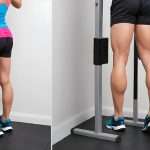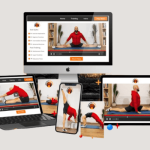Boost your workout routine with standing leg exercises. Say goodbye to endless hours on the floor and hello to a dynamic way to tone those legs. These exercises not only strengthen muscles but also improve balance and flexibility.
Whether you’re a fitness enthusiast or just starting, these moves are versatile and effective. Incorporate them into your regimen for a fun and challenging twist. Elevate your fitness game and feel the burn with standing leg exercises today!
Leg Muscles Overview
Muscle Groups
Standing leg exercises engage major muscle groups such as quadriceps, hamstrings, calves, and glutes. Each exercise targets specific muscles, aiding in balanced muscle development. By incorporating a variety of exercises, individuals can ensure they are engaging all these important muscle groups. Engaging various muscle groups is crucial for overall leg strength and stability.
Functionality
The functional benefits of standing leg exercises are immense. These exercises improve daily movements like walking, running, and climbing stairs by enhancing balance and coordination. Stronger leg muscles from these exercises also lead to better posture and reduce the risk of falls in older adults. The practical applications of stronger leg muscles extend to activities like carrying groceries, playing sports, or simply moving around with ease.
Importance
Incorporating leg exercises into a workout routine is vital for overall fitness. Leg strength plays a significant role in enhancing athletic performance and supporting proper body mechanics during activities. Strong legs are essential for preventing injuries, especially in sports that involve running, jumping, or sudden changes in direction. Regularly performing standing leg exercises can help individuals maintain healthy and injury-resistant legs.
Benefits of Standing Exercises
Toning Lower Body
Standing leg exercises are essential for toning the lower body, targeting muscles like quadriceps, hamstrings, and calves. These exercises contribute to enhancing muscle definition and shaping the legs effectively. Achieving a toned lower body through standing exercises can lead to improved overall physique and confidence.
No Weights Required
One of the significant advantages of standing leg exercises is that they can be done without any weights, making them convenient for home workouts or when access to gym equipment is limited. Using only body weight as resistance can still provide a challenging workout for the legs, promoting strength and endurance. Examples of equipment-free leg exercises include lunges, squats, and calf raises.
Enhancing Stability
Engaging in standing leg exercises plays a crucial role in enhancing balance and stability by strengthening the muscles supporting these functions. Building leg strength through these exercises directly impacts one’s ability to maintain stability during daily activities or sports. Exercises such as single-leg stands, step-ups, and side leg lifts specifically target stability by engaging core muscles along with the legs.
Essential Bodyweight Moves
Squats Variation
Wide Leg Squat
Wide leg squats involve standing with your feet wider than shoulder-width apart. Engage your core and lower down, keeping your back straight. This exercise primarily targets the quadriceps, hamstrings, and glutes. It also engages the inner thigh muscles. For beginners, holding onto a stable surface can assist in maintaining balance during wide leg squats.
Goblet Squat
Goblet squats are excellent for building leg strength and enhancing mobility. Hold a weight close to your chest while squatting. Goblet squats engage the quadriceps, hamstrings, and glutes effectively. They also promote better posture and spinal alignment. During goblet squats, focus on tightening your core muscles to stabilize your body throughout the movement.
Lunges Series
Reverse Lunge
Reverse lunges target the quadriceps, hamstrings, and glutes while improving balance and coordination. Step back into a lunge position. Compared to forward lunges, reverse lunges place less stress on the knees. To intensify, add weights or perform jump lunges. For those seeking a challenge, incorporating walking lunges or adding a pulse at the bottom of the lunge can increase difficulty.
Curtsy Lunge
Curtsy lunges involve crossing one leg behind the other at an angle while bending both knees. This move targets the glutes and inner thighs. Incorporating curtsy lunges into your routine can improve lower body strength and stability. Focus on proper form to maximize benefits.
Focused Leg Workouts
Glute Bridges
Glute bridges are essential for lower body strength as they target the glutes, hamstrings, and core muscles. Proper form involves lying on your back, knees bent, and lifting your hips off the ground. Variations like single-leg bridges can intensify the workout by focusing on one side at a time.
Leg Raises
Leg raises benefit core and leg muscles by engaging the lower abdominals and hip flexors. To perform them correctly, lie on your back, legs straight, and lift them towards the ceiling while keeping your lower back pressed into the floor. Variations such as flutter kicks or scissor kicks can add challenge and target different areas.
Hamstring Curls
Hamstring curls strengthen the back of the thighs, enhancing overall leg strength. Execute this exercise by lying face down on a leg curl machine, bending your knees to lift weights towards your buttocks. Including hamstring curls in your routine improves knee stability and athletic performance.
Dynamic Movement Exercises
Skaters
Skaters are dynamic movements that enhance leg strength and endurance while providing a cardiovascular workout. By mimicking the side-to-side motion of ice skaters, this exercise targets multiple muscle groups simultaneously. The explosive nature of skaters also helps in boosting agility and coordination.
Mountain Climbers
Mountain climbers engage various muscle groups, including the core, arms, and legs, making it a full-body workout. This exercise is highly effective for improving cardiovascular health due to its high-intensity nature. To increase intensity, one can try incorporating variations like cross-body mountain climbers or adding sliders for a smoother glide.
Side Shuffle
Side shuffles involve moving laterally from side to side, engaging the hip abductors and adductors along with the leg muscles. This movement pattern not only strengthens the lower body but also enhances agility and coordination. Incorporating side shuffles into a workout routine can help in improving overall athletic performance.
Creating a Workout Routine
Exercise Selection
When planning your standing leg exercises, choose based on your fitness goals, such as strength or endurance. Incorporate a variety of exercises to target different muscle groups effectively. Balance between exercises that focus on strength, stability, and flexibility for comprehensive leg workouts.
Routine Frequency
For optimal results, aim to perform standing leg exercises 2-3 times per week. Rest days are crucial to allow muscles to recover and grow stronger. Striking a balance between consistency in training and giving your body ample time to rest is key for progress.
Workout Duration
Ideal duration for leg workouts ranges from 30 to 60 minutes, depending on intensity and fitness level. Longer workouts don’t always mean better results; prioritize quality movements over quantity. Focus on proper form and engaging the targeted muscles effectively.
Performing Exercises Correctly
Proper Form
Maintaining proper form while doing standing leg exercises is crucial for effectiveness and safety. Focus on aligning your body correctly. Correct common mistakes like leaning forward or arching your back excessively to prevent strain and injury. Proper form not only ensures you target the right muscles but also reduces the risk of overloading certain joints.
Avoiding Injuries
To prevent leg injuries, always start with a thorough warm-up to prepare your muscles for the workout ahead. Incorporate dynamic stretches and mobility exercises into your routine to enhance flexibility and reduce injury risk. Listening to your body’s signals is key; avoid overtraining by recognizing when to rest or modify your workout intensity.
Maximizing Benefits
Optimize the benefits of standing leg exercises by focusing on nutrition and recovery. Fuel your body with nutrient-rich foods to support muscle growth. Adequate rest is essential for muscle repair and growth, so ensure you prioritize quality sleep and relaxation. Implementing progressive overload, where you gradually increase weights or reps, is vital for continual muscle development.
Advanced Tips and Tricks
Intensity Increase
To boost the effectiveness of standing leg exercises, increase the number of sets or reps. Incorporate high-intensity intervals to push your muscles further. Challenging your muscles is crucial for growth.
Introducing intensity variations keeps your workouts engaging. High-intensity intervals enhance endurance and stimulate muscle growth effectively. By pushing your limits, you encourage muscle adaptation and strength gains.
Variation Importance
Incorporating diverse leg exercise variations is vital for progress. Different exercises target muscles from various angles, preventing plateaus. Examples include lunges, squats, step-ups, and calf raises.
Variety in leg workouts prevents boredom and challenges your muscles differently each session. Changing exercises regularly ensures balanced muscle development and overall fitness improvements.
Consistency Key
Consistency is key for seeing results in standing leg exercises. Regular workouts aid in muscle recovery and growth. By sticking to a routine, you maintain muscle memory and progress steadily towards your fitness goals.
Regular leg workouts not only improve strength but also enhance endurance over time. Consistent training habits lead to better performance and increased muscle definition.
Closing Thoughts
You’ve gained valuable insights into the importance of standing leg exercises, the benefits they offer, and how to incorporate them into your workout routine. By focusing on essential bodyweight moves, targeted workouts, dynamic movements, and correct form, you’re well-equipped to enhance your leg strength and overall fitness levels. Remember to challenge yourself with advanced tips and tricks to keep progressing towards your fitness goals.
Take action now by implementing these standing leg exercises into your routine. Strengthen your lower body, improve balance, and boost your overall physical performance. Your commitment to incorporating these exercises will not only benefit your legs but also contribute to your overall health and well-being.
Standing Calf Raises: Mastering Form, Variations & Safety



